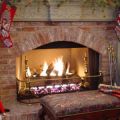How to do a chimney cap repair
Doing chimney caps that are composed of metal will help maintain a proper barrier that keeps the rain and snow from coming in and accumulating behind the fireplace walls.
The caps come in various designs and styles, like ones that are aerodynamic to reduce any downdraft from the passing winds and breezes. The cap also comes with many other features, including a solid top. But sometimes the fire you burn will send creosote particles out and they have been known to accumulate within the cap that could eventually block the proper flow of air needed.
When doing the chimney cap repair, the main goal is to clean off the built up creosote that can be a huge issue for most metal caps.
• The first step is to put on some shoes with rubber soles and some clothes that will fit loosely on you. Then you will want to set up your ladder – preferably an extension ladder that will extend to about three feet above the ease to allow a safer way to climb onto the roof. Don’t forget to bring a Phillips screwdriver and a wrench as these tools are the most important for this job.
• If you lift the chimney cap off and it is attached to the flue, you need to locate the screws and unscrew them using your screwdriver. Then you can use the wrench to hold the nuts steady during this part, provided there are nuts. This will allow you to be able to take the cap down to make any necessary repairs in your garage.
• One way to remove the built up creosote is to use a chisel and a hammer as a way of scraping it from the cap’s sides. It’s probably a good idea to wear protective gloves to keep your hands protected from the creosote. When you have chipped all of it off, you can collect what you have removed into a bag for disposal in the garbage can.
• While you have it detached, you have a chance to repair any joints that might have been separated. This can be done by screwing them back together with the use of self-tapping sheet metal screws. Afterwards, you can clamp that joint by using a C-clamp followed by using a drill and a No. 2 drill bit to drive the screw. On a side note, there’s no need to create any predrilled holes since the self-tapping screws will do that for you.
• With the chimney cap, you can then go back up the ladder onto the roof to make any needed repairs to the crown, which is the part that is the lining around the outside of the flue. Cleaning the crown can be done with a scrub brush and water that will remove the algae. This is also a good opportunity to find any cracks in the cap’s crown.
• If you find any cracks in the crown, you will need to seal them with the application of a crown sealant – which can be put on using a simple paintbrush. This product will provide water resistance will usually keep the water out of the chimney. One common mistake is some use it when the mortar is separating from the rest of the chimney.
• There might be a need for the more extensive repair by chipping off any loosened mortar by using that same chisel and hammer that was used for the excess creosote. What needs to be done is combining powdered mortar with water in a tray to create a stiff mixture and use a trowel to apply it into the spaces left by the older mortar that was chipped off. Then you need to slope the newer mortar away from the opening.
• Now you will want to set the chimney cap back into the proper position after the sealant has dried and the mortar is set 100 percent. You will want to fit this cap back around the flue, or you could always attach the cap with the support using screws to hold it in place.
For more info: Chimney relining
Source: Click Here
Other articles and publications:
- +1 (770) 255-1300
- 1155 McFarland 400 Drive, Alpharetta, GA
- www.chimneysolutions.com/



